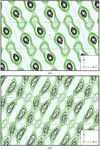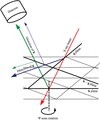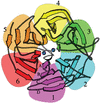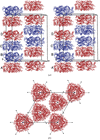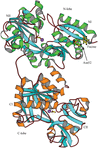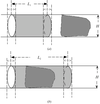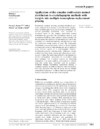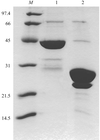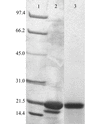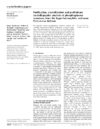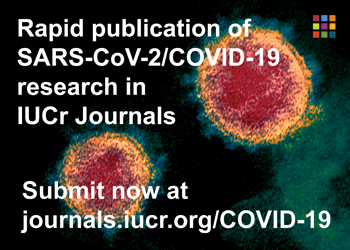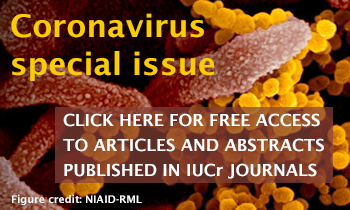issue contents
October 2003 issue
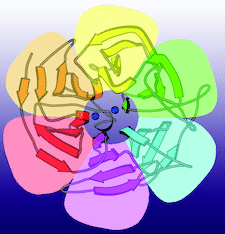
Cover illustration: Overall structure of the squid-type DFPase. View of the molecule down the pseudo-sixfold axis. The shaded propeller blades are colour coded from magenta to red, as are the four antiparallel β-strands belonging to each blade (p. 1744).
research papers
The crystal structure of the presynaptic viperotoxin F from the venom of Vipera russelli formosensis at 1.9 Å resolution has been determined and compared with that of the neurotoxin vipoxin from the venom of Vipera ammodytes ammodytes.
PDB reference: viperotoxin F, 1oqs, r1oqssf
Open  access
access
 access
accessStatistical density modification can make use of local patterns of density found in protein structures to improve crystallographic phases.
A connectivity-based phasing procedure starting from low resolution allows, in several favourable cases, identification of α-helices and β-strands in the corresponding ab initio phased Fourier maps.
Triplet phases were recorded from rhombohedral insulin crystals and optimized for sensitivity to the correctness of the solvent model. The data were used to quantify the improvement of phases during model refinement, with emphasis on evaluating the solvent refinement strategy.
In order to obtain a high-resolution structure of apo, unactivated insulin-like growth factor-1 receptor kinase, a number of variants of IGFRK-0P were prepared and screened for crystallization. A double mutant with E1067A and E1069A substitutions within the kinase-insert region resulted in crystals that diffracted to 1.5 Å resolution. Overall, the structure of the mutant IGFRK-0P is similar to that of the wild-type IGFRK-0P structure with the exception of the previously disordered kinase-insert region in the wild type having become fixed.
PDB reference: IGFRK-0P, 1p4o, r1p4osf
In-house sulfur-SAD phasing is demonstrated to be a useful method for overcoming model bias in molecular-replacement structure determination.
The atomic resolution crystal structure of tendamistat reveals a high degree of flexibility in the region that binds to pig pancreatic α-amylase. This flexibility may contribute to the very tight binding between the inhibitor and the target enzyme.
PDB reference: tendamistat, 1ok0, r1ok0sf
The most reliable residues of squid-type DFPase were refined without restraints and in a subsequent full-matrix refinement cycle estimated standard deviations for bond lengths, bond angles, torsion angles, hydrogen bonds and calcium coordination distances could be obtained. These data were compared with the restraints applied in the preceding refinement cycles to compile a statistical analysis that constitutes a first step towards a set of restraints based solely on macromolecular data.
PDB reference: squid ganglion DFPase, 1pjx, r1pjxsf
An analysis of the crystal structure of rhizopuspepsin determined at various pH values shows structural changes leading to the unfolding of the enzyme at a high pH.
Human phosphopantothenoylcysteine decarboxylase has been crystallized. The unit-cell parameters appear to be cubic and the Laue class appears to be ![[\bar 3]](/d/issues/2003/10/00/hm5003/teximages/hm5003fi1.gif) m, but as a result of pseudosymmetry in the crystal the true space group has been identified as R3.
m, but as a result of pseudosymmetry in the crystal the true space group has been identified as R3.
![[\bar 3]](/d/issues/2003/10/00/hm5003/teximages/hm5003fi1.gif) m, but as a result of pseudosymmetry in the crystal the true space group has been identified as R3.
m, but as a result of pseudosymmetry in the crystal the true space group has been identified as R3.PDB reference: phosphopantothenoylcysteine decarboxylase, 1qzu, r1qzusf
The first data acquisition from a virus crystal compressed at high pressure is reported. Results suggest that a quasi-parallel X-ray beam of ultrashort wavelength would improve conventional data collection.
This study presents the three-dimensional structure of diferric hen serum transferrin (hST) at 2.8 Å resolution. The variations in interdomain and interlobe interactions, together with altered lobe orientations in hST with respect to other transferrins, particularly to its same gene product hen ovotransferrin, are discussed.
PDB reference: hST, 1n04, r1n04sf
An analysis of atomic mobility in the structure of Pb2+-loaded calmodulin indicates that the two structurally similar domains of the protein exhibit different types of flexibility. The structure also displays an intriguing form of disorder that results in a lattice consisting of alternating well ordered and poorly ordered domains.
PDB reference: Pb2+-calmodulin, 1n0y, r1n0ysf
Using a new approach to make accurate measurements of the volume of a crystal, the authors developed a method to determine the number of macromolecules per asymmetric unit. This more accurate and convenient method has advantages over the traditional density-gradient methods.
A new method of reducing protein consumption by a modified vapour-diffusion protocol is described. In this protocol, the protein and mother liquor in the crystallization drop are both diluted, while the mother liquor in the well remains undiluted.
The complex multivariate normal distribution provides the basis for a variety of methods in crystallography and leads to insights into the underlying assumptions in multiple isomorphous phasing.
crystallization papers
The single calponin-homology domain of Rng2 from S. pombe has been overexpressed and purified. Monoclinic crystals have been obtained and Br- and Hg-derivative data sets have been measured to 2.21 Å using synchrotron radiation.
A disulfide linked heterodimeric platelet-aggregation inducer has been crystallized and preliminary data have been obtained.
The Phox homology domain of cytokine-independent survival kinase and its phosphoinositide complex have been crystallized using sodium malonate as the precipitant and cryoprotectant. The native protein crystal diffracted to 1.6 Å.
Galactokinase from P. furiosus has been crystallized and a MAD data set has been collected to 2.9 Å.
Phosphoglucose isomerase from P. furiosus has been crystallized and MAD data have been collected to 1.92 Å resolution.
Complete higher plant photosystem I (PSI) complex containing the PSI reaction centre and the light-harvesting complex LHCI has been crystallized and characterized; diffraction data were collected to 4.44 Å resolution.
Crystals of the complex between black-eyed pea trypsin and chymotrypsin inhibitor (BTCI) and bovine β-trypsin diffracted to 2.36 Å resolution and belong to the orthorhombic space group P212121, with unit-cell parameters a = 59.3, b = 61.8, c = 80.0 Å.
The extracellular hormone-binding domain of the atrial natriuretic peptide receptor (rat) has been expressed, purified, and crystallized in hormone-bound form from 2.0 M ammonium sulfate. X-ray data were collected to 3.1 Å with the crystals frozen in 3.4 M ammonium sulfate used as the cryoprotectant.
Crystallization of a nucleotide-dependent complex of the NG domains of the SRP GTPases Ffh and FtsY is reported.
OXG-RCBH from Geotrichum sp. M128 hydrolyzes the reducing end of oligoxyloglucan and produces two glucosyl residue segments. Crystals of the enzyme have been obtained and X-ray data have been collected to a resolution of 2.2 Å.
An ADP-ribose pyrophosphatase from an extreme thermophile, T. thermophilus HB8, has been crystallized. X-ray diffraction data were collected to 1.50 Å resolution.
Nucleoside diphosphate kinase from T. thermophilus HB8 was overexpressed in Escherichia coli, purified and crystallized. A complete native data set to 1.9 Å resolution has been collected.
The acetyl-esterase Aes from E. coli has been crystallized. The crystals belong to space group P212121 and diffract to 2.5 Å resolution.
The aphA gene from a pathogenic strain of S. enterica sv. Typhimurium, which encodes a class B non-specific acid phosphatase, has been cloned in the multicopy plasmid pBluescript SK−. Recombinant AphA purified from E. coli DH5α crystallizes in space group P212121, with a = 112.4, b = 130.2, c = 139.6 Å.
The crystallization and preliminary X-ray data of a novel round spermatid specific protein:RSB-66 are presented.
p75/AIRM1, also known as Siglec-7, is a sialoadhesin expressed on natural killer cells that inhibits their cytolytic activity. It is composed of an extracellular region comprising one IgV-like and two IgC-like domains. The extracellular IgV-like domain, believed to be involved in target-cell recognition, has been expressed in E. coli, folded in vitro and crystallized.
Crystals of the DH/PH domains of leukemia-associated RhoGEF (LARG) have been produced and diffract to 2.05 Å spacing using a synchrotron X-ray source. Xenon and NaBr derivatives were generated and the isomorphous and anomalous Patterson maps were analyzed.
Native and His-tagged mutant (L160I) T. tengcongensis hypoxanthine–guanine phosphoribosyltransferase with bound IMP and GMP have been crystallized in space groups C2221 and I222, respectively. X-ray diffraction data were collected to 2.2 and 1.7 Å, respectively.
The complex of importin-β and the HLHZ domain of SREBP-2 has been crystallized in the orthorhombic space groups P212121 and C2221.
DEAD proteins are members of a large and diverse family of RNA helicases. The cloning, expression, purification and crystallization of a putative member of this family from B. stearothermophilus that has a unique extension outside of the core region is described.
RluD, a 23S ribosomal RNA multi-site specific pseudouridine synthase from E. coli, has been crystallized. MAD data were collected to 2.0 Å on an SeMet derivative and structure determination is in progress.
short communications
1,4-Diphenyl-2-butene, a competitive MAO B inhibitor that interferes with the binding of MAO B inhibitors, was found to originate from polystyrene microbridges used for MAO B crystallization.
Two neutral lanthanide complexes, Yb-HPDO3A and Lu-HPDO3A, are shown to be excellent compounds to obtain high-phasing-power heavy-atom derivatives. SAD experiments with hen egg-white lysozyme derivative crystals indicate that these compounds are particularly interesting for optimized anomalous diffraction experiments using synchrotron radiation.


 journal menu
journal menu













